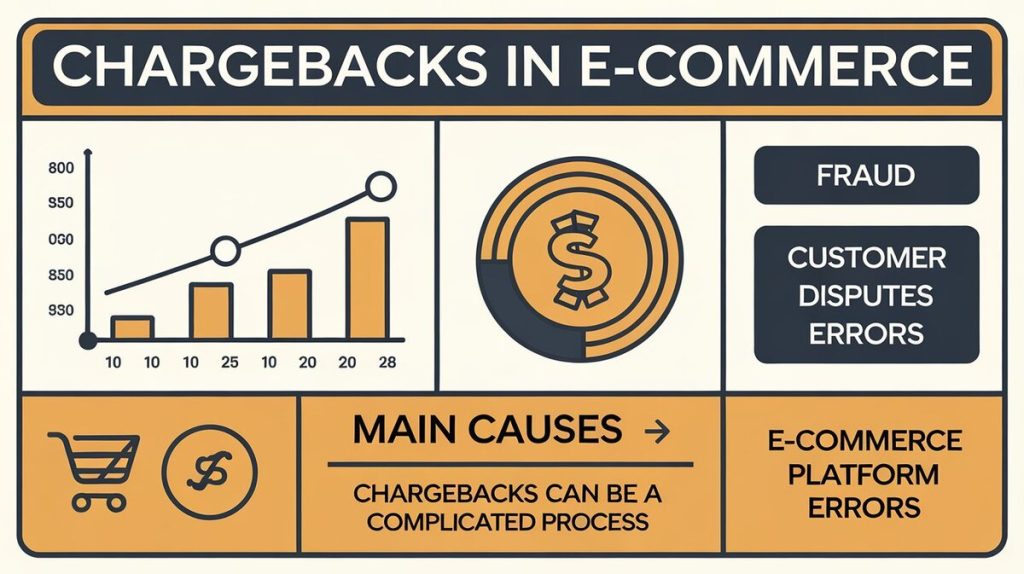Introduction
Chargebacks are a major challenge for e-commerce businesses. They happen when a customer disputes a transaction, resulting in the reversal of funds and additional fees for the merchant. In 2023, over 615 million chargebacks were filed globally, leading to $117 billion in disputed transactions. Understanding chargebacks and how to manage and prevent them is essential for protecting your business’s bottom line.
What Are Chargebacks?
A chargeback occurs when a cardholder disputes a transaction through their bank, often because of fraud, billing errors, or dissatisfaction with a purchase. Payment networks like Visa and Mastercard facilitate chargebacks to protect consumers, but they also pose significant risks for merchants.
| Category | Reason for Chargebacks | Merchant Response |
|---|---|---|
| Unauthorized use | Fraudulent use of card details | Provide purchase and security records |
| Billing mistakes | Wrong charges, non-receipt | Show correct invoices and shipping data |
| Product dissatisfaction | Product not as described | Provide clear product information and service |
Chargebacks typically follow these steps:
- Customer files a dispute.
- The bank reverses the charge.
- Merchants submit evidence.
- The bank issues a final decision.
Why Do Chargebacks Happen?
Understanding the causes of chargebacks helps in minimizing their frequency. Chargebacks can arise from fraud, dissatisfaction, or merchant errors.
Fraud
Fraudulent transactions are a leading cause of chargebacks. These occur when stolen card information is used to make unauthorized purchases. Third-party fraud accounts for about 40% of chargebacks.
Dissatisfaction
Customers may file chargebacks because of billing issues, shipping delays, or discrepancies in product descriptions.
Friendly Fraud
Friendly fraud occurs when customers dispute legitimate purchases, either by mistake or to avoid paying. This type of fraud makes up nearly 50% of chargebacks.
| Type of Fraud | Example | Merchant Impact |
|---|---|---|
| Third-party fraud | Stolen credit cards | Loss of product, fees, customer trust |
| Friendly fraud | Legitimate purchases disputed | Operational costs in resolving issues |

Financial Impact of Chargebacks
Chargebacks lead to direct financial losses through lost sales and chargeback fees, which range from $30 to $100 per instance. Over time, frequent chargebacks can lead to increased transaction fees or even account suspension. The indirect costs, such as time spent resolving disputes and damaging relationships with payment processors, can also add up.
| Fee Type | Amount |
|---|---|
| Credit card provider fee | $30 – $100 |
| Increased transaction fees | Up to 4.5% for high-risk merchants |
Preventing Chargebacks
To prevent chargebacks, businesses should take proactive measures to reduce fraud and improve customer satisfaction.
Fraud Prevention Tools
- Use Address Verification Systems (AVS) and Card Verification Values (CVV) to validate cardholder information.
Accurate Product Information
Ensure that your product descriptions and images are accurate to prevent customers from being disappointed with their purchases.
Clear Policies
Display clear refund, return, and cancellation policies to help manage customer expectations. When customers know your policies, they’re less likely to bypass you and go straight to their bank.
Responsive Customer Service
Offering responsive customer service can prevent many disputes. Issues like delayed shipments or product dissatisfaction can be handled more effectively through fast, open communication. Implement live chat or 24/7 support to resolve problems quickly.
| Method | Benefit |
|---|---|
| AVS and CVV | Prevents unauthorized transactions |
| Accurate product info | Reduces chargebacks from unmet expectations |
| Clear policies | Prevents disputes from policy misunderstandings |

Managing Chargebacks
Even with preventive measures, chargebacks can still occur. Managing them effectively is key to minimizing their financial impact.
Dispute Process
When a chargeback is initiated, gather the necessary documentation:
- Proof of delivery: Provide tracking and shipping confirmations.
- Payment records: Submit invoices and transaction history.
- Customer communication: Include any emails or messages that confirm product issues.
Submitting clear and thorough evidence increases your chances of winning a dispute. Platforms like Stripe offer integrated tools to monitor and manage chargebacks. Timely responses with the right documentation can often lead to a favorable outcome.
Monitoring Chargeback Ratios
Keep your chargeback ratio below 1% to avoid increased fees or account suspension. Payment processors, including Visa and Mastercard, monitor this ratio closely. A ratio above 1% could result in higher fees or even the loss of your account.
| Dispute Documentation | Example |
|---|---|
| Proof of delivery | Shipping confirmation, tracking |
| Payment records | Invoices, transaction data |
| Customer communication | Emails confirming product issues |
The Role of Chargeback Management Solutions
Many merchants turn to third-party solutions to manage disputes. Companies like Merchanto.org, an official partner of Visa and Mastercard, specialize in identifying chargeback risks and managing disputes. These services provide tools for:
- Fraud detection
- Real-time dispute monitoring
- Comprehensive chargeback reporting
Partnering with chargeback management platforms can help reduce the workload of handling disputes and improve the chances of winning. Visit Merchanto.org to learn more about how their tools can help your business.
Conclusion
Chargebacks are a common issue for e-commerce businesses, but they can be managed and prevented. By implementing fraud prevention measures, providing clear product descriptions, and offering responsive customer service, businesses can minimize chargeback risks. When chargebacks do occur, prompt and thorough dispute management is key to reducing losses.
| Table Recap |
|---|
| Table 1: Common chargeback causes and merchant responses |
| Table 2: Financial impact and chargeback fees |
| Table 3: Prevention methods and benefits |
These strategies, combined with the right tools, can help e-commerce businesses minimize the impact of chargebacks and maintain profitability.



